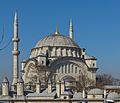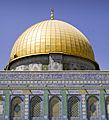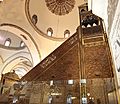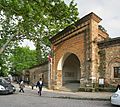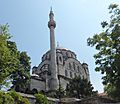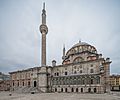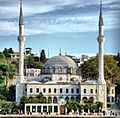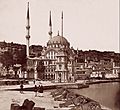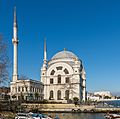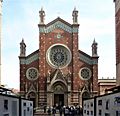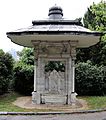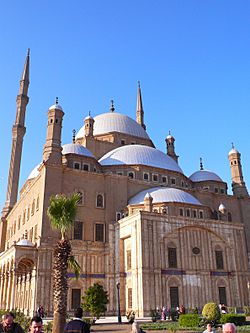
Mohamed Ali Mosque, Cairo; an example of classic Ottoman architecture
Ottoman architecture is the architecture of the Ottoman Empire. It emerged in Bursa and Edirne in 14th and 15th centuries. The architecture of the empire developed from the earlier Seljuk architecture. It was influenced by the Byzantine, Iranian and Seljuk architecture. It was also influenced by Islamic Mamluk traditions after the conquest of Constantinople by the Ottomans. For almost 400 years Byzantine architectural artifacts such as the church of Hagia Sophia served as models for many of the Ottoman mosques. Overall, Ottoman architecture has been described as Ottoman architecture synthesized with architectural traditions of the Mediterranean and the Middle East.
The Ottomans achieved the highest level architecture in their lands. They mastered the technique of building vast inner spaces confined by seemingly weightless yet massive domes. Their work achieved harmony between inner and outer spaces, as well as light and shadow. Islamic religious building, which until then was simple but with extensive decoration, was transformed by the Ottomans. They used vaults, domes, semi-domes and columns. The mosque was changed from being a cramped and dark chamber with arabesque-covered walls into a beautiful sanctuary.
Images for kids
-
Blue Mosque in Istanbul, an example of the classical style of Ottoman architecture, showing Byzantine influence.
-
Example of a "T-plan" layout: the floor plan of the Green Mosque in Bursa
-
-
16th-century illustration showing the original Fatih Mosque (top)
-
Floor plan and elevation of the Şehzade Mosque (drawings by Cornelius Gurlitt)
-
The Fruit Room in the Harem of Topkapı Palace (1705)
-
Nuruosmaniye Mosque, Istanbul (completed in 1755)
-
Tophane Barracks of Selim III (right), seen in an 1819 engraving by Melling
-
Stefan Sveti Church (1895–1898), the first steel building in Istanbul
-
Grand Post Office in Sirkeci, Istanbul: one of the first Ottoman Revival buildings (1909)
-
Tile decoration in the Green Mosque in Bursa (1424)
-
Cuerda seca tilework in the tomb of Şehzade Mehmed (1548)
-
-
Details of tiles at the Rüstem Pasha Mosque (circa 1561), with early use of the "tomato red" colour
-
Tekfursaray tiles in the Hekimoğlu Ali Paşa Mosque (1734), including a depiction of the Great Mosque of Mecca
-
Hacı Özbek Mosque in Iznik (1333)
-
Green Mosque in Iznik (1378–1391)
-
Green Mosque interior: "Turkish triangles" form the transition from dome to square chamber
-
Interior of Yildirim Bayezid Mosque in Mudurnu (circa 1389)
-
Orhan Gazi Mosque in Bursa (1339): exterior and front portico
-
Orhan Gazi Mosque: interior prayer hall, view towards the qibla
-
Hüdavendigar Mosque in Bursa (1366–1385): interior of the prayer hall
-
Nilüfer Hatun Imaret in Iznik (1388)
-
Yıldırım Bayezid I Mosque in Bursa (1395): exterior and portico
-
Yıldırım Bayezid I Mosque: interior view towards the qibla iwan
-
Firuz Bey Mosque in Milas (1394): exterior façade
-
Green Mosque in Bursa (1412–1424): exterior façade and entrance portal
-
-
Green Mosque: mihrab and tile decoration
-
Green Tomb in Bursa (1412–24), part of the Green Mosque complex
-
Interior of the Green Tomb
-
Beylerbeyi Mosque in Edirne (1428–1429): interior view of the qibla iwan
-
Grand Mosque of Bursa (1396–1400)
-
Interior of the Grand Mosque of Bursa
-
Wooden minbar of the Grand Mosque of Bursa
-
Old Mosque of Edirne (1403–1414)
-
Interior of the Old Mosque of Edirne
-
Interior of the Bedesten of Bursa (with modern-day shops)
-
Exterior view of the Bedesten of Edirne
-
Tomb of Murad II at the Muradiye Complex in Bursa (circa 1426)
-
Entrance to the Murad II Medrese in Bursa (circa 1426)
-
Remains of tile and fresco decoration in the Murad II Mosque in Edirne (circa 1435)
-
Üç Şerefeli Mosque in Edirne (1437–1447): exterior
-
Üç Şerefeli Mosque: courtyard
-
Üç Şerefeli Mosque: interior
-
Yedikule Fortress in Istanbul (circa 1458)
-
Interior of the Sandal Bedesten in the Grand Bazaar, Istanbul
-
Interior of the Tahtakale Hamam (dome is original but the balconies are modern)
-
Mahmut Pasha Hamam, Istanbul (1466)
-
Mahmut Pasha Hamam: dome interior
-
Bab-ı Hümayun, the outer gate to the Topkapi Palace (1478–1479, with later renovations)
-
Babüsselam, the gate to the Second Court in Topkapi Palace
-
Fatih Kiosk in the Third Court of Topkapi Palace (1462–1463)
-
Tiled Kiosk in the outer gardens of Topkapi Palace (1472)
-
Tile decoration of the Tiled Kiosk
-
Bayezid II Mosque in Amasya (1486)
-
Bayezid II Complex in Edirne (1484–1488)
-
Interior of the mosque at the Bayezid II Complex in Edirne
-
Inner courtyard of the darüşşifa at the Bayezid II Complex in Edirne
-
Bayezid II Mosque in Istanbul (1500–1505)
-
Bayezid II Mosque in Istanbul: dome interiors
-
Bayezid II Hamam, part of the Bayezid II complex in Istanbul
-
Yavuz Selim I Mosque in Istanbul (1522), designed by unknown architect
-
Yavuz Selim I Mosque interior
-
-
Fatih Pasha Mosque interior, view of the dome
-
Çoban Mustafa Pasha Mosque in Gebze (1523–1524)
-
-
Haseki Hürrem Sultan Complex in Istanbul (1538–1539), designed by Sinan
-
Tomb of Hayreddin Barbaros in Beşiktaş (1541), designed by Sinan
-
-
Şehzade Mosque: view of the exterior and one of the lateral porticos
-
-
Cemetery of the complex, including the Tomb of Şehzade Mehmed
-
Mihrimah Sultan Mosque in Üsküdar (1547–1548)
-
Double porch in front of the Mihrimah Sultan Mosque
-
Rüstem Pasha Medrese in Istanbul (1550)
-
Mosque of the Sulaymaniyya Takiyya in Damascus (1554–1559)
-
Haseki Hürrem Hammam in Istanbul (1556–1557)
-
Güzelce Aqueduct near Istanbul (between 1554 and 1564)
-
Stari Most in Mostar (1555–1566), built by Sinan's assistant Hayruddin
-
-
Süleymaniye Mosque courtyard
-
Süleymaniye Mosque interior
-
Tomb of Suleiman in the cemetery behind the Süleymaniye Mosque
-
Interior of the Tomb of Suleiman
-
Salis Medrese, one of the madrasas in the Süleymaniye complex
-
Hadim Ibrahim Mosque in Istanbul (1551)
-
Sinan Pasha Mosque in Istanbul (1553–1555)
-
Sinan Pasha Mosque: view of the central dome, looking towards the side
-
Kara Ahmet Pasha Mosque in Istanbul (1554)
-
Kara Ahmet Pasha Mosque interior
-
Sokollu Mehmed Pasha Complex in Lüleburgaz, founded circa 1560: view of the mosque and madrasa courtyard
-
Sokollu Mehmed Pasha Complex in Lüleburgaz: interior of the mosque
-
Rüstem Pasha Mosque in Istanbul (circa 1561)
-
Rüstem Pasha Mosque interior, with Iznik tile decoration
-
Rüstem Pasha Mosque interior, view of the dome
-
Mihrimah Sultan Mosque in Istanbul (1565)
-
Mihrimah Sultan Mosque interior
-
Sokollu Mehmed Pasha Mosque in Istanbul (1571)
-
Sokollu Mehmed Pasha Mosque in Istanbul: view of the interior and the mihrab
-
-
Buttresses and vertical progression on the exterior of the mosque
-
Selimiye Mosque interior, view of the dome
-
Selimiye Mosque interior, view of the dome (detail)
-
Selimiye Mosque interior, ground-level view
-
Sultan's loge inside the mosque
-
Details of the stone minbar, including pierced geometric decoration
-
Tomb of Selim II (1576–1577)
-
Interior of the Tomb of Selim II
-
Kılıç Ali Pasha Mosque in Istanbul (1580–1581)
-
Kılıç Ali Pasha Mosque interior
-
Chamber of Murad III in Topkapı Palace (1578)
-
Şemsi Paşa Complex in Istanbul (1580), on the shore of Üsküdar
-
Atik Valide Mosque in Istanbul (completed in 1584)
-
Atik Valide Mosque interior
-
Murad III Mosque in Manisa (1585)
-
Murad III Mosque interior
-
Nişancı Mehmed Pasha Mosque, Istanbul (circa 1589)
-
Interior of Nişancı Mehmed Pasha Mosque
-
Garden courtyard of the Nişancı Mehmed Pasha Mosque
-
Cerrah Pasha Mosque, Istanbul (1593)
-
Interior of Cerrah Pasha Mosque
-
Gazanfer Ağa Medrese, Istanbul (1596)
-
Tomb of Murad III, Istanbul (1599)
-
-
Sultan Ahmed Mosque interior
-
Baghdad Kiosk in Topkapı Palace (1639)
-
Interior of the Baghdad Kiosk
-
New Mosque (Yeni Cami) in Istanbul (completed in 1663)
-
-
Egyptian Bazaar (Spice Bazaar) in Istanbul, built as part of the New Mosque complex
-
Yeni Valide Mosque complex in Üsküdar (1708–1711)
-
Yeni Valide Mosque Ceiling
-
Ahmed III Fountain near Hagia Sophia (1728)
-
Ahmed III Fountain details
-
Ahmed III Fountain in Üsküdar (1728)
-
Tophane Fountain of Mahmud I (1732)
-
Hekimoğlu Ali Pasha Fountain (1732)
-
Bereketzade Fountain (1732)
-
Saliha Sultan Sebil and Fountain (1732)
-
Sebil of the Damat Ibrahim Pasha Complex in Istanbul (1720)
-
Rızvaniye Mosque Complex in Urfa (1721–1722)
-
Damat Ibrahim Pasha Moque in Nevşehir (1726)
-
Hekimoğlu Ali Pasha Mosque in Istanbul (1734)
-
Library built above the gate of the Hekimoğlu Ali Pasha Mosque complex
-
Sebil of the Hekimoğlu Ali Pasha Mosque complex
-
Hekimoğlu Ali Pasha Mosque interior
-
Entrance to the Fatih Mosque's cemetery, with the Fountain of Nisançı Ahmed Pasha (1741–42) on the far left
-
Hacı Mehmet Emin Ağa Sebil, Istanbul (1741–42)
-
Fountain of Mahmud I at Hagia Sophia, Istanbul (1740–41)
-
Gate to the imaret of Hagia Sophia, Istanbul (1743)
-
Beşir Ağa Mosque and sebil, Istanbul (1745)
-
Sebil of the Seyyid Hasan Pasha complex, Istanbul (1745)
-
Mixtilinear arches in the lateral portico and windows of the mosque
-
Semi-vault above one of the mosque entrances, with Baroque friezes replacing muqarnas
-
-
-
-
Imperial pavilion: a ramp on the right leads to a private lounge connected to the mosque on the left
-
The tomb (left) and library (right) of the complex
-
Cihanoğlu Mosque in Aydın (1756)
-
Ayazma Mosque in Üsküdar (1760–61)
-
Laleli Mosque in Istanbul (1760–1764)
-
Interior of the Laleli Mosque in Istanbul (1760–1764)
-
Tomb and Sebil of the Laleli Mosque complex
-
Fatih Mosque in Istanbul, rebuilt by Mustafa III (completed in 1771)
-
Reconstructed tomb of Mehmed II behind the Fatih Mosque (circa 1771)
-
Beylerbeyi Mosque on the Bosphorus, near Istanbul (circa 1778, with later renovations)
-
Tomb of Abdülhamid I in Istanbul (circa 1780)
-
Sebil of Abdülhamid I, Istanbul (circa 1780)
-
Sebil of the Mihrişah Sultan Complex in Eyüp, Istanbul (1792–1796)
-
Eyüp Sultan Mosque in Istanbul, rebuilt by Selim III (1798–1800)
-
Tomb of Şah Sultan in Eyüp, Istanbul (1800–1801)
-
Selimiye Barracks in Üsküdar, originally built by Selim III (circa 1803) but rebuilt by Mahmud II
-
Selimiye Mosque in Üsküdar, Istanbul (1801–1805): view of the front façade and entrance portico
-
Selimiye Mosque: side view with external gallery and part of the imperial pavilion (right)
-
Interior of Selimiye Mosque
-
Baths of the Sultan and Queen Mother, Topkapı Palace, renovated circa 1744 by Mahmud I
-
Sofa Kiosk, Topkapı Palace, restored by Mahmud I in 1752
-
Interior of Sofa Kiosk restored by Mahmud I in 1752
-
Baroque decoration in the Imperial Hall in the Harem of Topkapı Palace (18th century)
-
Baroque decoration on the exterior of the Imperial Council (Divan) Hall in Topkapı Palace
-
Engraving (by Melling) of Hadice Sultan's Palace on the Bosphorus, Istanbul (18th century)
-
Azm Palace, Damascus (circa 1750)
-
Ishak Pasha Palace, near present-day Doğubayazıt (completed around 1784)
-
Tomb of Nakşidil Sultan in Istanbul (1818)
-
Nusretiye Mosque in Tophane, Istanbul (1822–1824)
-
Interior of the Nusretiye Mosque
-
One of the sebils of the Nusretiye Mosque
-
1830s illustration of the Tophane Barracks built by Mahmud II (with the Nusretiye Mosque behind)
-
Cevri Kalfa School in Istanbul (1819)
-
Tower of Justice in Topkapı Palace (1820)
-
Tomb of Hüsrev Pasha in Eyüp, Istanbul (1839)
-
-
Interior of the Tomb of Mahmud II
-
-
-
External façade of the selamlık
-
Crystal Staircase in the selamlik section of the palace
-
External façade of the Ceremonial Hall
-
Interior of the Ceremonial Hall
-
Mecidiye Kiosk in Topkapı Palace (1840)
-
Ihlamur Pavilion, Istanbul (1849–1855)
-
Küçüksu Pavilion, Istanbul (1856)
-
Beylerbeyi Palace, Istanbul (completed 1864–1865)
-
Interior of Beylerbeyi Palace
-
Çırağan Palace, Istanbul (1872)
-
Büyük Mabeyn Köşkü, built during reign of Abdülaziz (r. 1861–1876)
-
Chalet Pavilion, built by Abdülhamid II (multiple building phases)
-
The "Mother-of-Pearl" Hall inside the Chalet Pavilion
-
Malta Kiosk in Yıldız Park
-
Çadir Kiosk in Yıldız Park
-
Hamidiye Mosque (1886), the official mosque of the palace
-
Interior of Hamidiye Mosque: view towards the rear and the imperial balconies
-
Küçük Mecidiye Mosque, Istanbul (1848): front view facing the imperial pavilion
-
Küçük Mecidiye Mosque interior
-
Dolmabahçe Mosque, Istanbul (1853–1855), seen from the water
-
Front view of the Dolmabahçe Mosque and its imperial pavilion
-
Dolmabahçe Mosque interior
-
Ortaköy Mosque, Istanbul (1854–1856)
-
Ortaköy Mosque entrance, between the two wings of the imperial pavilion
-
Interior of the Ortaköy Mosque
-
Pertevniyal Valide Mosque, Istanbul (1871)
-
Interior of the Pertevniyal Valide Mosque
-
Aziziye Mosque, Konya (1872)
-
Surp Asdvadzadzin Church in Beşiktaş, Istanbul (1838)
-
Hagia Triada Church in Beyoğlu, Istanbul (1880)
-
Italian Synagogue in Istanbul (1880s)
-
Phanar Greek Orthodox College building in Istanbul (1881)
-
Surp Asdvadzadzin Church (Kurtuluş Mosque today) in Gaziantep(1878–1893)
-
Hagia Kyriaki Church in Kumkapı, Istanbul (1895)
-
Ashkenazi Synagogue in Istanbul (1900)
-
Church of St. Anthony in Beyoğlu, Istanbul (1906–1912)
-
Safranbolu Clock Tower (1798)
-
Tophane Clock Tower in Istanbul (circa 1848)
-
Clock tower in the Citadel of Bursa (first built by Sultan Abdülaziz but rebuilt in 1905)
-
Adana Clock Tower or Büyük Saat (1882)
-
Yıldız Clock Tower inside Yıldız Palace (1890)
-
Dolmabahçe Clock Tower in Istanbul (1890–1894)
-
-
Konak Clock Tower in Izmir (1901)
-
Shopping arcade of Avrupa Pasajı (1874)
-
Cité de Pera building and entrance to the Çiçek Pasajı (1876)
-
-
Ottoman Bank building in Galata, Istanbul (1890)
-
Londra Hotel in Istanbul (1891)
-
Pera Palace Hotel in Istanbul (1895)
-
Pera Palace Hotel interior
-
Entrance to the Suriye Pasajı (1908)
-
Exterior of the Sirkeci Railway Station in Istanbul (1888–1890), designed in Orientalist style
-
Interior hall in the Sirkeci Station
-
Haydarpaşa Station in Istanbul (rebuilt 1906–1908)
-
Interior hall of the Haydarpaşa Station
-
Camondo Stairs in Galata (circa 1860)
-
Fountain of Abdülhamid II (1896–1901), located today in Maçka Park
-
Botter Apartment on Istiklal Street, by Raimond D'Aronco (1900–1901)
-
Laleli Fountain in Galata (1905, unconfirmed architect)
-
Tomb of Sheikh Zafir, by Raimond D'Aronco (1905–1906)
-
Interior of the Tomb of Sheikh Zafir
-
Defter-i Hakani building in Sultanahmet, Istanbul, built by Vedat Tek
-
Bebek Mosque in Bebek, Istanbul, designed by Mimar Kemaleddin Bey (1913)
-
The 4th Vakıf Han in Sirkeci, Istanbul, by Kemaleddin Bey (c. 1914)
-
Tayyare Apartments in Laleli, Istanbul, by Kemaleddin Bey (1919–1922)
-
Sultanahmet Jail (1916–1917)
-
Tiles in the Tomb of Roxelana, Istanbul (1558)
-
Tiles in the mihrab of the Rüstem Pasha Mosque, Istanbul (circa 1561)
-
Tiles in the outer portico of the Rüstem Pasha Mosque, Istanbul (circa 1561)
-
TIles in the Mausoleum of Suleiman, Istanbul (1566)
-
Tile decoration in the Sokullu Mehmed Pasha Mosque, Istanbul (1572)
-
Detail of tiles in the Sokullu Mehmed Pasha Mosque, Istanbul (1572)
-
Tilework near the mihrab in the Selimiye Mosque, Edirne (circa 1574)
-
Detail of tiles in the Selimiye Mosque, Edirne (circa 1574)
-
Detail of tiles in the Selimiye Mosque, Edirne (circa 1574)
-
Tile panel at the entrance to the Tomb of Selim II in Istanbul (1576)
-
Tiles in the Atik Valide Mosque, Istanbul (1583)
-
Tiles (with painted decoration above) on the back wall of the Sultan Ahmed I Mosque, Istanbul (circa 1617)
-
Detail of tiles in the Sultan Ahmed I Mosque, Istanbul (circa 1617)
-
Tiled mihrab of the Çinili Mosque (1640)
-
Iznik tiles in the Aqsunqur Mosque in Cairo, Egypt (1652)
-
The tiled interior of the Hünkâr Kasrı (sultan's pavilion) at the New Mosque, Istanbul (circa 1663)
See also
 In Spanish: Arquitectura otomana para niños
In Spanish: Arquitectura otomana para niños

 In Spanish: Arquitectura otomana para niños
In Spanish: Arquitectura otomana para niños







